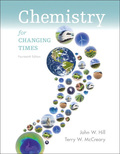
Concept explainers
a)
Interpretation:
To mention the structure of alcohol that can be oxidized to 
Concept Introduction:
Alcohol belongs to the class of organic chemical compounds that comprise of a part consisting of an oxygen atom, which is attached to a carbon atom in the molecule, to which a single hydrogen atom is attached.
Oxidization can be defined as the process or a
Interpretation:
To mention the structure of alcohol that can be oxidized to 
Concept Introduction:
Alcohol belongs to the class of organic chemical compounds that comprise of a part consisting of an oxygen atom, which is attached to a carbon atom in the molecule, to which a single hydrogen atom is attached.
Oxidization can be defined as the process or a chemical reaction which involves the moving of the electrons. In terms of Oxygen it is ‘gain of oxygen’, in terms of hydrogen it is ‘loss of hydrogen’ and in terms of electrons it is ‘loss of electron’.
Interpretation:
To mention the structure of alcohol that can be oxidized to 
Concept Introduction:
Alcohol belongs to the class of organic chemical compounds that comprise of a part consisting of an oxygen atom, which is attached to a carbon atom in the molecule, to which a single hydrogen atom is attached.
Oxidization can be defined as the process or a chemical reaction which involves the moving of the electrons. In terms of Oxygen it is ‘gain of oxygen’, in terms of hydrogen it is ‘loss of hydrogen’ and in terms of electrons it is ‘loss of electron’.
d)
Interpretation:
To mention the structure of alcohol that can be oxidized to 
Concept Introduction:
Alcohol belongs to the class of organic chemical compounds that comprise of a part consisting of an oxygen atom, which is attached to a carbon atom in the molecule, to which a single hydrogen atom is attached.
Oxidization can be defined as the process or a chemical reaction which involves the moving of the electrons. In terms of Oxygen it is ‘gain of oxygen’, in terms of hydrogen it is ‘loss of hydrogen’ and in terms of electrons it is ‘loss of electron’.
Trending nowThis is a popular solution!

Chapter 9 Solutions
EBK CHEMISTRY FOR CHANGING TIMES
- LIOT S How would you make 200. mL of a 0.5 M solution of CuSO4 5H2O from solid copper (II) sulfate? View Rubricarrow_forwardSteps and explantions pleasearrow_forwardMatch the denticity to the ligand. Water monodentate ✓ C₂O2 bidentate H₂NCH₂NHCH2NH2 bidentate x EDTA hexadentate Question 12 Partially correct Mark 2 out of 2 Flag question Provide the required information for the coordination compound shown below: Na NC-Ag-CN] Number of ligands: 20 Coordination number: 2✔ Geometry: linear Oxidation state of transition metal ion: +3 x in 12 correct out of 2 question Provide the required information for the coordination compound shown below. Na NC-Ag-CN] Number of ligands: 20 Coordination number: 2 Geometry: linear 0 Oxidation state of transition metal ion: +3Xarrow_forward
- Can you explain step by step behind what the synthetic strategy would be?arrow_forwardPlease explain step by step in detail the reasoning behind this problem/approach/and answer. thank you!arrow_forward2. Predict the product(s) that forms and explain why it forms. Assume that any necessary catalytic acid is present. .OH HO H₂N OHarrow_forward
- consider the rate of the reaction below to be r. Whats the rate after each reaction? Br + NaCN CN + NaBr a. Double the concentration of alkyl bromide b. Halve the concentration of the electrophile & triple concentration of cyanide c. Halve the concentration of alkyl chloridearrow_forwardPredict the organic reactant that is involved in the reaction below, and draw the skeletal ("line") structures of the missing organic reactant. Please include all steps & drawings & explanations.arrow_forwardWhat are the missing reagents for the spots labeled 1 and 3? Please give a detailed explanation and include the drawings and show how the synthesis proceeds with the reagents.arrow_forward
- What is the organic molecule X of the following acetal hydrolysis? Please draw a skeletal line structure and include a detailed explanation and drawing of how the mechanism proceeds. Please include any relevant information that is needed to understand the process of acetal hydrolysis.arrow_forwardWhat are is the organic molecule X and product Y of the following acetal hydrolysis? Please draw a skeletal line structure and include a detailed explanation and drawing of how the mechanism proceeds. Please include any relevant information that is needed to understand the process of acetal hydrolysis.arrow_forwardAt 300 K, in the decomposition reaction of a reactant R into products, several measurements of the concentration of R over time have been made (see table). Without using graphs, calculate the order of the reaction. t/s [R]/(mol L-1) 0 0,5 171 0,16 720 0,05 1400 0,027arrow_forward
 ChemistryChemistryISBN:9781305957404Author:Steven S. Zumdahl, Susan A. Zumdahl, Donald J. DeCostePublisher:Cengage Learning
ChemistryChemistryISBN:9781305957404Author:Steven S. Zumdahl, Susan A. Zumdahl, Donald J. DeCostePublisher:Cengage Learning ChemistryChemistryISBN:9781259911156Author:Raymond Chang Dr., Jason Overby ProfessorPublisher:McGraw-Hill Education
ChemistryChemistryISBN:9781259911156Author:Raymond Chang Dr., Jason Overby ProfessorPublisher:McGraw-Hill Education Principles of Instrumental AnalysisChemistryISBN:9781305577213Author:Douglas A. Skoog, F. James Holler, Stanley R. CrouchPublisher:Cengage Learning
Principles of Instrumental AnalysisChemistryISBN:9781305577213Author:Douglas A. Skoog, F. James Holler, Stanley R. CrouchPublisher:Cengage Learning Organic ChemistryChemistryISBN:9780078021558Author:Janice Gorzynski Smith Dr.Publisher:McGraw-Hill Education
Organic ChemistryChemistryISBN:9780078021558Author:Janice Gorzynski Smith Dr.Publisher:McGraw-Hill Education Chemistry: Principles and ReactionsChemistryISBN:9781305079373Author:William L. Masterton, Cecile N. HurleyPublisher:Cengage Learning
Chemistry: Principles and ReactionsChemistryISBN:9781305079373Author:William L. Masterton, Cecile N. HurleyPublisher:Cengage Learning Elementary Principles of Chemical Processes, Bind...ChemistryISBN:9781118431221Author:Richard M. Felder, Ronald W. Rousseau, Lisa G. BullardPublisher:WILEY
Elementary Principles of Chemical Processes, Bind...ChemistryISBN:9781118431221Author:Richard M. Felder, Ronald W. Rousseau, Lisa G. BullardPublisher:WILEY





